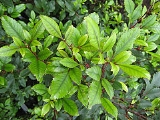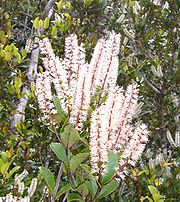
Weinmannia racemosa
Encyclopedia

Tree
A tree is a perennial woody plant. It is most often defined as a woody plant that has many secondary branches supported clear of the ground on a single main stem or trunk with clear apical dominance. A minimum height specification at maturity is cited by some authors, varying from 3 m to...
of the family Cunoniaceae
Cunoniaceae
The Cunoniaceae is a family of 26 genera and about 350 species of woody plants in the Antarctic flora, with many laurifolia species with glossy leaves endemic to laurel forest habitat. The family is native to Australia, New Caledonia, New Guinea, New Zealand, southern South America, the Mascarene...
, is a very common tree in New Zealand
New Zealand
New Zealand is an island country in the south-western Pacific Ocean comprising two main landmasses and numerous smaller islands. The country is situated some east of Australia across the Tasman Sea, and roughly south of the Pacific island nations of New Caledonia, Fiji, and Tonga...
, occurring in lowland, montane, and subalpine forests and shrubland from the central North Island
North Island
The North Island is one of the two main islands of New Zealand, separated from the much less populous South Island by Cook Strait. The island is in area, making it the world's 14th-largest island...
south to Stewart Island.
According to the 1966 Encyclopedia of New Zealand, it is 'the most abundant forest tree in New Zealand'. Sometimes beginning life as an epiphyte
Epiphyte
An epiphyte is a plant that grows upon another plant non-parasitically or sometimes upon some other object , derives its moisture and nutrients from the air and rain and sometimes from debris accumulating around it, and is found in the temperate zone and in the...
on the trunks of tree ferns, kāmahi attains its greatest height of 25 or more metres in the Catlins forests of the south-eastern South Island
South Island
The South Island is the larger of the two major islands of New Zealand, the other being the more populous North Island. It is bordered to the north by Cook Strait, to the west by the Tasman Sea, to the south and east by the Pacific Ocean...
. It has small creamy-white flowers in erect spike
Raceme
A raceme is a type of inflorescence that is unbranched and indeterminate and bears pedicellate flowers — flowers having short floral stalks called pedicels — along the axis. In botany, axis means a shoot, in this case one bearing the flowers. In a raceme, the oldest flowers are borne...
s. Kāmahi generally occurs with other broadleaf trees, at times acting as a pioneer species
Pioneer species
Pioneer species are species which colonize previously uncolonized land, usually leading to ecological succession. They are the first organisms to start the chain of events leading to a livable biosphere or ecosystem...
which is eventually succeeded by the southern beeches (Nothofagus
Nothofagus
Nothofagus, also known as the southern beeches, is a genus of 35 species of trees and shrubs native to the temperate oceanic to tropical Southern Hemisphere in southern South America and Australasia...
spp.) or podocarps. In forests to the west of the Southern Alps
Southern Alps
The Southern Alps is a mountain range extending along much of the length of New Zealand's South Island, reaching its greatest elevations near the island's western side...
it grows in association with southern rātā (Metrosideros umbellata
Metrosideros umbellata
Southern rātā , is a tree endemic to New Zealand. It grows up to 15 m. or more tall with a trunk up to 1 m. or more in diameter. It produces masses of red flowers in summer...
). Because the wood
Wood
Wood is a hard, fibrous tissue found in many trees. It has been used for hundreds of thousands of years for both fuel and as a construction material. It is an organic material, a natural composite of cellulose fibers embedded in a matrix of lignin which resists compression...
of kāmahi has a tendency to warp or crack, it is little used despite its abundance. A closely related tree, tōwai or tawhero (W. silvicola
Weinmannia silvicola
Weinmannia silvicola, known as Tōwai or Tawhero, a medium-sized tree of the family Cunoniaceae, is a very common tree in the north of the North Island of New Zealand, occurring in forest and forest margins from North Cape south to the Waitakere Ranges west of Auckland...
), replaces kāmahi in the North Island north of latitude 37°S
37th parallel south
The 37th parallel south is a circle of latitude that is 37 degrees south of the Earth's equatorial plane. It crosses the Atlantic Ocean, the Indian Ocean, Australasia, the Pacific Ocean and South America....
.
Further reading
- Metcalf, Laurie, 2002. A Photographic Guide to Trees of New Zealand. Tāmaki-makau-rau: New Holland.
- Salmon, J.T., 1986. The Native Trees of New Zealand. Te Whanga-nui-a-Tara: Heinneman Reed.

